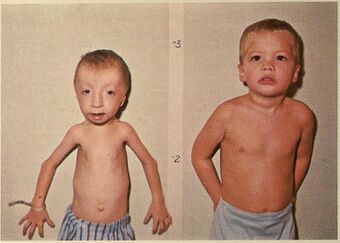Medicine:Seckel syndrome
| Seckel syndrome | |
|---|---|
| Other names | Harper's syndrome |
 | |
| Boy with Seckel syndrome (left) | |
| Specialty | Medical genetics |
| Causes | defects of genes on chromosome 3 and 18. |
Seckel syndrome, or microcephalic primordial dwarfism (also known as bird-headed dwarfism, Harper's syndrome, Virchow–Seckel dwarfism and bird-headed dwarf of Seckel[1]) is an extremely rare congenital nanosomic disorder. Inheritance is autosomal recessive.[2] It is characterized by intrauterine growth restriction and postnatal dwarfism with a small head, narrow bird-like face with a beak-like nose, large eyes with down-slanting palpebral fissures,[3] receding mandible and intellectual disability.
A mouse model has been developed.[4] This mouse model is characterized by a severe deficiency of ATR protein.[4] These mice have high levels of replicative stress and DNA damage. Adult Seckel mice display accelerated aging.[4] These findings are consistent with the DNA damage theory of aging.
History
The syndrome was named after German–American physician Helmut Paul George Seckel[5] (1900–1960). The synonym Harper's syndrome was named after pediatrician Rita G. Harper.[6][7]
Symptoms and signs
Symptoms include:
- intellectual disability (more than half of the patients have an IQ below 50)
- microcephaly
- sometimes pancytopenia (low blood counts)
- cryptorchidism in males
- low birth weight
- dislocations of pelvis and elbow
- unusually large eyes
- blindness or visual impairment
- large, low-set ears
- small chin due to receded lower jaw
Genetics
It is believed to be caused by defects of genes on chromosome 3 and 18. One form of Seckel syndrome can be caused by mutation in the gene encoding the ataxia telangiectasia and Rad3-related protein (ATR) which maps to chromosome 3q22.1–q24. This gene is central in the cell's DNA damage response and repair mechanism.
Types include:
| Type | OMIM | Gene | Locus |
|---|---|---|---|
| SCKL1 | Online Mendelian Inheritance in Man (OMIM) 210600 | ATR | 3q22–q24 |
| SCKL2 | Online Mendelian Inheritance in Man (OMIM) 606744 | ? | 18p11–q11 |
| SCKL3 | Online Mendelian Inheritance in Man (OMIM) 608664 | ? | 14q |
| SCKL4 | Online Mendelian Inheritance in Man (OMIM) 613676 | CENPJ | 13q12 |
Diagnosis
Treatment
See also
- Koo-Koo the Bird Girl
References
- ↑ "Bird-headed dwarf of Seckel". J Indian Soc Pedod Prev Dent 25 Suppl: S8–9. 2007. PMID 17921644. http://www.jisppd.com/article.asp?issn=0970-4388;year=2007;volume=25;issue=5;spage=8;epage=9;aulast=Harsha.
- ↑ James Wynbrandt; Mark D. Ludman (February 2008). The encyclopedia of genetic disorders and birth defects. Infobase Publishing. pp. 344–. ISBN 978-0-8160-6396-3. https://books.google.com/books?id=kXaMjwItP0oC&pg=PA344. Retrieved 7 January 2011.
- ↑ "Nephrolithiasis in a 17-Year-Old Male With Seckel Syndrome and Horseshoe Kidneys: Case Report and Review of the Literature". Urology 120: 241–243. 2018. doi:10.1016/j.urology.2018.05.023. PMID 29894776.
- ↑ 4.0 4.1 4.2 "A mouse model of ATR-Seckel shows embryonic replicative stress and accelerated aging". Nat. Genet. 41 (8): 891–8. August 2009. doi:10.1038/ng.420. PMID 19620979.
- ↑ Seckel, H. P. G. Bird-headed Dwarfs: Studies in Developmental Anthropology Including Human Proportions. Springfield, Ill.: Charles C Thomas (pub.) 1960.
- ↑ "Seckel's syndrome". http://www.whonamedit.com/synd.cfm/869.html.
- ↑ "Bird-beaded dwarfs (Seckel's syndrome). A familial pattern of developmental, dental, skeletal, genital, and central nervous system anomalies". J. Pediatr. 70 (5): 799–804. May 1967. doi:10.1016/S0022-3476(67)80334-2. PMID 6022184.
External links
| Classification | |
|---|---|
| External resources |
 |

